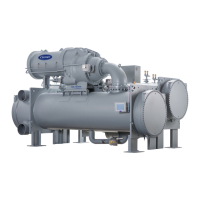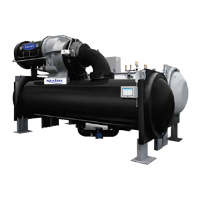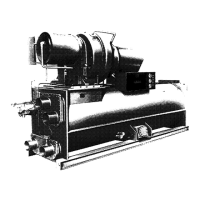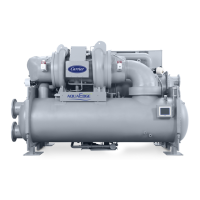Leak Test Chiller — Due to regulations regarding re-
frigerant emissions and the difficulties associated with sepa-
rating contaminants from the refrigerant, Carrier recommends
the following leak test procedure. See Fig. 25 for an outline
of the leak test procedure. Refer to Fig. 26 and 27 during
pumpout procedures and Tables 5A and 5B for refrigerant
pressure/temperature values.
1. If the pressure readings are normal for the chiller
condition:
a. Evacuate the holding charge from the vessels, if present.
b. Raise the chiller pressure, if necessary, by adding
refrigerant until pressure is at the equivalent saturated
pressure for the surrounding temperature. Follow the
pumpout procedures in the Transfer Refrigerant from
Pumpout Storage Tank to Chiller section, Steps 1a - e,
page 63.
Never charge liquid refrigerant into the chiller if
the pressure in the chiller is less than 35 psig
(241 kPa) for HFC-134a. Charge as a gas only, with
the cooler and condenser pumps running, until this
pressure is reached, using PUMPDOWN LOCK-
OUT and TERMINATE LOCKOUT mode on
the PIC II. Flashing of liquid refrigerant at low
pressures can cause tube freeze-up and consider-
able damage.
c. Leak test chiller as outlined in Steps3-9.
2. If the pressure readings are abnormal for the chiller
condition:
a. Prepare to leak test chillers shipped with refrigerant
(Step 2h).
b. Check for large leaks by connecting a nitrogen bottle
and raising the pressure to 30 psig (207 kPa). Soap
test all joints. If the test pressure holds for 30 minutes,
prepare the test for small leaks (Steps 2g - h).
c. Plainly mark any leaks that are found.
d. Release the pressure in the system.
e. Repair all leaks.
f. Retest the joints that were repaired.
g. After successfully completing the test for large leaks,
remove as much nitrogen, air, and moisture as pos-
sible, given the fact that small leaks may be present in
the system. This can be accomplished by following
the dehydration procedure, outlined in the Chiller
Dehydration section, page 51.
h. Slowly raise the system pressure to a maximum of
160 psig (1103 kPa) but no less than 35 psig (241 kPa)
for HFC-134a by adding refrigerant. Proceed with the
test for small leaks (Steps 3-9).
3. Check the chiller carefully with an electronic leak detec-
tor, halide torch, or soap bubble solution.
4. Leak Determination — If an electronic leak detector in-
dicates a leak, use a soap bubble solution, if possible, to
confirm. Total all leak rates for the entire chiller. Leakage
at rates greater than 1 lb/year (0.45 kg/year) for the entire
chiller must be repaired. Note the total chiller leak rate
on the start-up report.
5. If no leak is found during the initial start-up procedures,
complete the transfer of refrigerant gas from the
pumpout storage tank to the chiller (see Transfer Refrig-
erant from Pumpout Storage Tank to Chiller section,
page 63). Retest for leaks.
6. If no leak is found after a retest:
a. Transfer the refrigerant to the pumpout storage tank
and perform a standing vacuum test as outlined in the
Standing Vacuum Test section, below.
b. If the chiller fails the standing vacuum test, check for
large leaks (Step 2b).
c. If the chiller passes the standing vacuum test, dehy-
drate the chiller. Follow the procedure in the Chiller
Dehydration section. Charge the chiller with refriger-
ant (see Transfer Refrigerant from Pumpout Storage
Tank to Chiller section, page 63).
7. If a leak is found after a retest, pump the refrigerant back
into the pumpout storage tank or, if isolation valves are
present, pump the refrigerant into the non-leaking ves-
sel (see Pumpout and Refrigerant Transfer procedures
section).
8. Transfer the refrigerant until the chiller pressure is at
18 in. Hg (40 kPa absolute).
9. Repair the leak and repeat the procedure, beginning from
Step 2h, to ensure a leak-tight repair. (If the chiller is opened
to the atmosphere for an extended period, evacuate it be-
fore repeating the leak test.)
Standing Vacuum Test — When performing the stand-
ing vacuum test or chiller dehydration, use a manometer or
a wet bulb indicator. Dial gages cannot indicate the small
amount of acceptable leakage during a short period of time.
1. Attach an absolute pressure manometer or wet bulb in-
dicator to the chiller.
2. Evacuate the vessel (see Pumpout and Refrigerant
Transfer Procedures section, page 62) to at least 18 in.
Hg vac, ref 30-in. bar (41 kPa), using a vacuum pump or
the pumpout unit.
3. Valve off the pump to hold the vacuum and record the
manometer or indicator reading.
4. a. If the leakage rate is less than 0.05 in. Hg (0.17 kPa)
in 24 hours, the chiller is sufficiently tight.
b. If the leakage rate exceeds 0.05 in. Hg (0.17 kPa)
in 24 hours, repressurize the vessel and test for leaks.
If refrigerant is available in the other vessel, pres-
surize by following Steps 2-10 of Return Chiller To
Normal Operating Conditions section, page 64. If not,
use nitrogen and a refrigerant tracer. Raise the vessel
pressure in increments until the leak is detected. If
refrigerant is used, the maximum gas pressure is
approximately 70 psig (483 kPa) for HFC-134a at nor-
mal ambient temperature. If nitrogen is used, limit the
leak test pressure to 230 psig (1585 kPa) maximum.
5. Repair the leak, retest, and proceed with dehydration.
48

